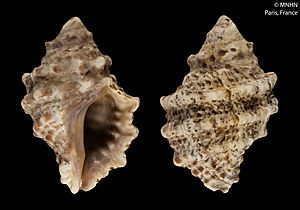Oyster borer facts for kids
Quick facts for kids Haustrum scobina |
|
|---|---|
 |
|
| Shell of Haustrum scobina (lerctotype at MNHN, Paris) | |
| Scientific classification | |
| Kingdom: | |
| Phylum: | |
| Class: | |
| (unranked): |
clade Caenogastropoda
clade Hypsogastropoda clade Neogastropoda |
| Superfamily: |
Muricoidea
|
| Family: |
Muricidae
|
| Subfamily: |
Haustrinae
|
| Genus: |
Haustrum
|
| Species: |
H. scobina
|
| Binomial name | |
| Haustrum scobina (Quoy & Gaimard, 1833)
|
|
| Synonyms | |
|
|
The oyster borer, also known as Haustrum scobina, is a type of sea snail. It's a marine mollusk, which means it's an animal with a soft body, often protected by a shell. This snail belongs to the Muricidae family, also called murex snails or rock snails.
Oyster borers are predators. They use a special slimy layer around their shell opening. This layer helps them stay moist and not dry out. You can often find them in cracks and small spaces. These spots offer protection from other animals and from the sun and wind. They also have more water and a more stable temperature.
About the Oyster Borer Snail
The oyster borer is a fascinating sea creature. It's a type of gastropod, which is a large group of mollusks. Snails and slugs are both gastropods.
What Does It Look Like?
The shell of an oyster borer can be different sizes. It usually measures between 14 millimeters and 35 millimeters long. That's about half an inch to one and a half inches.
Where Does It Live?
This snail is endemic to New Zealand. This means it is found only in New Zealand and nowhere else in the world. You can find it around the North, South, and Stewart Islands. It also lives near the Chatham Islands.
Oyster borers like to live in areas where the tide goes in and out. These are called inter-tidal zones. A good example is the Hauraki Gulf near Auckland, New Zealand.

